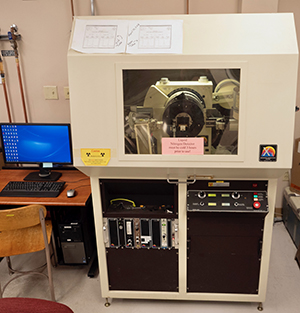X-Ray Powder Diffraction Spectrometer
SCINTAG X1 Diffraction System

X-ray Powder Diffraction (XRD) is an efficient analytical technique used to identify and characterize unknown crystalline materials. Monochromatic x-rays are used to determine the interplanar spacings of the unknown materials. Samples are analyzed as powders with grains in random orientations to insure that all crystallographic directions are "sampled" by the beam. When the Bragg conditions for constructive interference are obtained, a "reflection" is produced, and the relative peak height is generally proportional to the number of grains in a preferred orientation.
The x-ray spectra generated by this technique, thus, provide a structural fingerprint of the unknown. Mixtures of crystalline materials can also be analyzed and relative peak heights of multiple materials may be used to obtain semi-quantitative estimates of abundances. A glancing x-ray beam may also be used to obtain structural information of thin films on surfaces. In addition, changes in peak position that represent either compositional variation (solid solution) or structure-state information (e.g. order-disorder transitions, exsolution, etc.) are readily detectable. Peak positions are reproducible to 0.02 degrees.
Data reduction routines rapidly determine peak position, relative intensities, and calculate intracrystalline d-spacings. The complete ASTM powder diffraction file is available on-line for identification of unknown crystalline materials.
The advantages of X-ray Powder Diffraction are:
- Rapid identification of materials
- Ease of sample preparation
- Computer-aided material identification
- Large library of known crystalline structures
- Multi-sample stage

